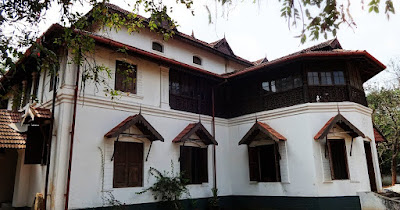 |
| Kollengode palace, Thrissur.upload.wikimedia.org |
Above image: Kollemkode palace, Chembookkavu, Thrissur, Kerala, India, built in 1904 by Raja of Kollengode. The ruler had a good rapport with the British Raj. Now it is an Archaeological museum dedicated to the heritage of Kerala and mural paintings, etc......................
 |
| Kollengode Palace,Thirussuavalshe9.blogspot.com |
The Kollengode Palace in Udaya Nagar, Chembukkav, Thrissur city is different from the original Kollengode (Kalari kovilakam) in Palakkad and visitors to Kerala often mistake the one for the other. The one at Thrissur built by the Raja of Kollengode, Vasudeva Raja in 1904 was gifted by him to his daughter. Kollengode was once the seat of power ruled by Kollengode dynasty - Vengandu Swaroopam also went by the name of the name of Vengandu Nambidi’s; they ruled eastern side of Palakkad and they got the title of ''Raja'' from Hyder Ali, then ruler of Mysore and father of Tipu Sultan. The Valluvakonathiri (ruler of Valluvanad), the rulers of Vengunad (Kollengodu Rajas) and Sekhari Varma (Raja of Palakkad) were popular rulers of this region, after the Cherman Perumals.
Characterized by a simple blend of native architecture and European design elements, it is not a highly embellished palace of north Indian states. Nor does it look huge and grand in style. Nope. The distinctive aspect of palaces in SW Indian state of Kerala is its ''elegance in simplicity.'' They are impressive, inspiring and cool to our eyes as they are in sync with native culture and terrain, ghat area that gets lots of rain during the monsoons. The slopping tiled roof and gables at certain places and elaborate use of wood in the form of rafters, pillars, beams and cross beams, etc., make them stand apart. The masonry walls are thick that gives the structure a strong base. The extended sloping roof over the windows, balcony, etc., gives extra protection to the walls as well as to the wooden structure in he rainy seasons. Set in the midst of a garden with trees and plants all around, the interiors are cool. As it was wont in the past and also in the present, this palace was designed and built based on Vastsu Sastras.
After the Department of Archaeology, Kerala in 1975 acquired the property they converted it into a heritage museum dedicated mainly to Kerala. After that period, in 2009 they introduced a Mural gallery (Chuvarchitra Kala Museum) section that includes beautiful murals amazing paintings, manuscripts and inscriptions. The Kerala Lalithakala Akademi was instrumental in installing sculptures made of terracotta, marble and cement at the museum. This was done to highlight the tradition of Thrissur, its art and cultures. The Mural Art Museum was functioning in the Town Hall building Thrissur.
The museum replicates some of the rarest mural paintings in its purest form. the collections include those from the Mattancherry Palace, Pundarikapuram Temple, Kanjoor Church. Also included are vintage oldest sketches of the holy places like Badarinath, Rameshwaram, Kasi and Kanyakumari.
he Palace houses a gallery of murals from all over Kerala and preserves a rare treasure of Veera Kallu, temple models, palm manuscripts , some personal collections of Vasudeva Raja, life-size statues of eminent personalities, a megalithic collection of earthen pots, Nannangadi (urn burials) black and red wares, black wares russet-coated wares, stone age tools, etc from Indus Valley Civilisation and Harappa and Cheraman Parambu (Kodungallur). Rare collections of stone sculptures dating from the 7th century to the 10th century and bronze sculptures dating from the 12th century to the 18th century.
It was in April 2013 the state government sanctioned Rs. Rs 5.21 crore towards its renovation and conversion into a heritage museum dedicated mainly to Kerala. The government and the conservationists restored the old palace structure back to glory without making any changes to the architecture of the existing building. A major plan was on the anvil to start such a museum at Sreepadam Palace at Thiruvananthapuram, Velu Tampi Dalawa Memorial Museum at Pathanamthitta and Pazhassi Kudeeram at Wayanad. The archaeological and heritage museums at Bastian Bungalow in Fort Kochi and construction work took roots during this period- 2013.
A word of appreciation for the Kerala government, this project was as part of its major plan to construct heritage museums in all districts that will benefit the posterity. Unfortunately, many Indian states never give importance to heritage aspect and only in the past four or five years the awareness among the other states has gone up to preserve and safeguard our deep-rooted cultural ethos and heritage.
Museum: timing. Open on all days except Mondays and National holidays from 9.00 am to 4.30 pm.
Nearest airport : Cochin International Airport, about 58 km to the south










.jpg)



